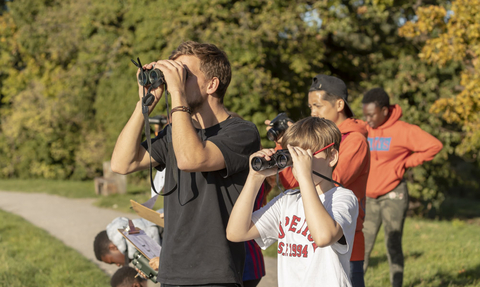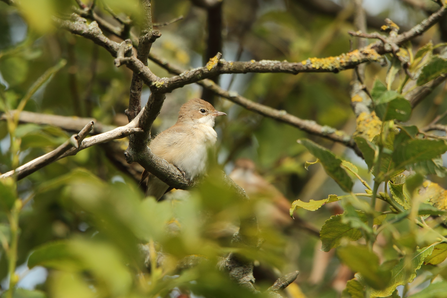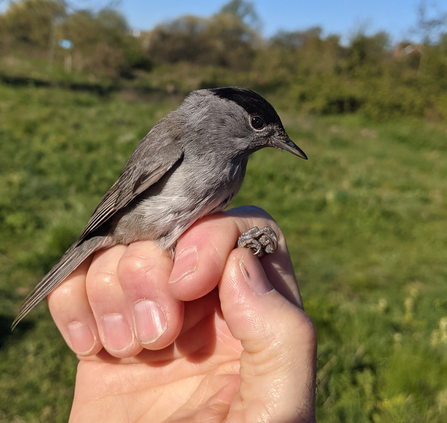
Penny Dixie
Birds at Walthamstow Wetlands
Walthamstow Wetlands is a Site of Special Scientific Interest (SSSI). It also forms part of the Lee Valley Special Protection Area and is a Ramsar wetland designated site of international importance.
The ten reservoirs on-site offer a haven for overwintering wildfowl such as pochard and gadwall and are regionally important for breeding birds such as grey heron, tufted duck and little egret. Swifts visit during the summer and kingfisher and peregrine falcon can be seen all year round.
Bird sightings

© Ian Phillips
Birds come to the site for a variety of reasons - to feed, to breed, to roost, to moult, for safety from predators. The areas of open water and the islands are particularly attractive for them. Birds also come here at different times of the year. In the winter, when waters in northern Europe freeze and the ground is covered by snow, wildfowl such as ducks, geese and swans come south to the UK for water and feeding. By the spring, many of these will have gone back but others such as warblers, terns, martins, and swift, come north to breed here, returning south before winter. Others can be seen here all year.
54 key wetland bird species have been identified at Walthamstow Wetlands between 2004-2009 as part of the Wetland Birds Count (WeBS). The WeBS count is undertaken by local volunteers, working to the British Trust for Ornithology’s methodology. Out of these 54 birds, 37 of these were considered rare including garganey, kingfisher and green sandpiper. Additional surveys are undertaken by London Wildlife Trust every fortnight to ensure the Wetlands’ conservation status is effectively monitored. The site also provides suitable nesting sites and foraging terrain for a number of terrestrial birds, in particular the trees and scrubland around reservoirs 1,2 and 3.
Bird Monitoring Reports
© Ian Phillips
The Bird Monitoring Report 2020-21 is the third report on the populations and distribution of key bird species at Walthamstow Wetlands published by London Wildlife Trust. The Trust has continued monitoring beyond the five-year monitoring plan required by the Habitat Regulations Assessment and after discharging Planning Conditions 20 & 21 for Walthamstow Wetlands. This is due to the Trust recognising some changes to distribution and populations of species since the site opened in 2017. The Trust will continue to monitor key bird populations, distribution and disturbance in response to increased public access and will present findings in future annual monitoring reports.
Read the Bird Monitoring Reports
Birdwatching permits
© Ian Phillips
A birdwatching permit entitles you to visit restricted areas and outside of public opening hours, to observe and enjoy the wildlife found at Walthamstow Wetlands. Spaces are limited, and the cost is £10 for the year, which goes towards bird ringing activities at the reserve. We are not accepting renewals; current bird permit holders and new applicants complete the same form and are entered into the same lottery draw.
Applications are now closed for 2025-26 bird permits, they will re-open on 1 April 2026 for 2026-27 permits.
Find out more about birdwatching permits
Please only apply if you fit the following criteria:
-
You will visit Walthamstow Wetlands for bird or wildlife watching.
-
You will visit Walthamstow Wetlands at least once a fortnight.
This ensures that the limited number of permits available are enjoyed by people who visit the reserve regularly to watch wildlife. We encourage people from all backgrounds and communities to apply. If you do not meet these criteria or are unsuccessful, you are welcome to visit during our regular opening hours.
Please note: If you are found to be participating in activities outside of these agreed parameters, your permit will be revoked. You may be asked to show proof of your permit, so please always carry it with you when on-site.
For wildlife monitoring purposes, please notify one of the reserve staff if you find anything of ecological interest to add to our records. We thank you for your contribution.
For any enquiries, please check our FAQs below first.
Birdwatching permit FAQs
1. What is the cost of the permit?
- The cost for an annual permit is £10. Day permits are no longer distributed.
2. What does the annual permit include?
- The permit entitles permit holders to increased access to Walthamstow Wetlands. For example, the site is usually open between 9:30am - 4/5pm, whilst the birdwatching permit entitles you access to the reservoirs before and after these public-access times. The permit will also give you access to sensitive wildlife areas which are closed to the general public at certain times of the year to protect the wildlife, breeding grounds, and habitats.
3. Why is there an application process?
- Walthamstow Wetlands is a Site of Special Scientific Interest (SSSI), a Ramsar wetland designated site of international importance and forms part of the Lee Valley Special Protection Area (SPA). Following the 2017 opening of the site to the wider public, there has been an unprecedented interest in visiting the reserve out of normal visitor centre hours (910:30 am - 4/5 pm). As a result, the application process allows us to manage the number of people visiting the site out of hours and the number of people with access to sensitive habitats and wildlife areas.
4. How do you apply for a birdwatching permit?
- Permits commence June 1st each year and are valid until May 31st the following year. Applications are currently open, please find more information about how to apply above.
5. Who will be reviewing the applications and deciding?
- The Wetlands team will review all applications and will be issuing a total of 75 permits based on a lottery style draw. Numbers are limited to 75 and not all applications will therefore be successful. This process will be reviewed each year.
6. When should I apply?
- Applications for new permits must be submitted by 7th May each year.
7. When will successful applicants be notified?
- Successful applicants will be notified by 21st May each year.
8. Who should I contact for further details?
- Please contact wawbirdpermits@wildlondon.org.uk with any questions – we will endeavour to get back to you as quickly as possible.
Bird ringing

© Pete Salter
A newly formed volunteer group whose aim is to study the birds of Walthamstow Wetlands, to understand their breeding success, longevity, and movements in the wider Lee Valley catchment area and as an important stepping-stone for resident and migratory species by trapping and ringing them.
